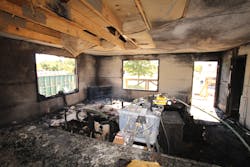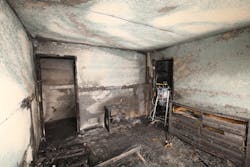Research Corner: Airborne Contamination During Post-Fire Investigations
It has been well documented that today’s structure fires can produce high levels of airborne particulate and gases/vapors, including certain aldehydes, polycyclic aromatic hydrocarbons (PAHs) and volatile organic compounds (VOCs). Furthermore, several studies identified firefighters’ increased occupational cancer risks. Although much of the existing fire service-related exposure research focuses on fire response, risks that are encountered by post-fire scene investigators haven’t been characterized nearly as well.
The occupational exposure risks during fire responses often are high in concentration but relatively short in duration. Although important gaps remain in firefighter PPE, typical modern turnout gear and SCBA are designed to help to mitigate these risks. On the other hand, fire investigators typically work in lower levels of airborne environmental contamination than structural firefighters do, but the amount of time that fire investigators might be on scene regularly is measured in hours or even days. According to the International Association of Arson Investigators, the time frames in which fire scenes are investigated may be categorized based on time after fire extinguishment was completed:
- Hot Scene A: Fire was extinguished and overhaul is in progress or didn’t yet commence
- Hot Scene B: Fire was fully extinguished/overhauled for fewer than two hours
- Warm Scene: Fire was fully extinguished for at least two hours but as many as 72 hours
- Cold Scene: Fire was fully extinguished for more than 72 hours and isn’t generating detectable or visible products of combustion
Relatively few studies focused on the exposure risks that fire investigators face while they complete their work. In their Bureau of Alcohol, Tobacco, Firearms and Explosives report, HETA 96-0171-2692, which was based on environmental monitoring during investigations, Gregory Kinnes and Gregg Hine noted that several fire investigators who didn’t wear respiratory protection experienced both eye and respiratory irritation during investigations.
Mattias Sjostrom and his co-authors of “Airborne and Dermal Exposure to Polycyclic Aromatic Hydrocarbons, Volatile Organic Compounds, and Particles among Firefighters and Police Investigators,” assessed environmental exposures for police forensic investigators during investigations and found that the investigators were exposed to benzene, naphthalene and total dust during Warm and/or Cold Scene investigations.
Kenneth Fent and his co-authors of “Evaluation of Dermal Exposure to Polycyclic Aromatic Hydrocarbons in Fire Fighters” found that particulate and certain VOC concentrations during Hot Scene B investigations were elevated in some experiments.
Fire investigators currently lack comprehensive information on which to determine appropriate levels of PPE that should be worn from Hot Scene A through Cold Scene investigations and what monitoring should take place to support these decisions. Often, the use of PPE among fire investigators is limited, which potentially increases their susceptibility to carcinogenic exposures.
To help to address this gap, UL’s Fire Safety Research Institute (FSRI) conducted a study to characterize airborne contaminants that might be encountered while investigating a residential fire scene from within a few minutes after fire extinguishment (Hot Scene A) to as many as five days after fire suppression (Cold Scene).What was found
Median particulate that measures 2.5 micrometers or less (PM2.5) that was encountered during Hot Scene B were 103.5 µg/m3 for all experiments and 191 µg/m3 for the larger common room fires. This corresponds to air quality index (AQI) values of 176 (unhealthy) and 241 (very unhealthy). At the very unhealthy level, individuals who have heart disease should avoid any outdoor activity; all others are recommended to avoid prolonged exertion.
It should be noted that AQI indices are based on 24-hour average outdoor concentrations, and FSRI’s measurements were averaged over one hour. Nevertheless, the guidance at these levels is appropriate for investigators who might be digging out a scene or conducting other activities in high concentrations of particulate.
After extending particulate data collection to several days after suppression, peak concentrations from transient events still were elevated, although typically not as high as the immediate post-fire operations, other than one scenario when some additional ceiling collapsed. At the five-day post-fire investigation period, investigators actively removed drywall from compartment ceilings and walls to inspect structural components and building systems that might have been compromised by the fire. During these days, the median respirable and total particulate levels over the 60-minute investigation period were 826 µg/m3 and 1,841 µg/m3, with peak levels of 20,950 µg/m3 and 47,050 µg/m3.
According to the authors of “Ultrafine (nanometre) particle mediated lung injury,” particulate that’s in the respirable size range can penetrate and deposit into the gas exchange regions of the respiratory system. In the general population, at least three studies showed strong associations between elevations in ambient fine particulate concentrations and increases in hospital admissions and mortality rates. In three other studies, exposure to fireground particulate was proposed as an important contributing factor for sudden cardiac events in the fire service.
Many of the existing fireground exposure studies focus on PAH and VOC contamination, specifically naphthalene and benzene. For the investigation time frames that were reported in this study, the concentrations of these compounds were relatively low relative to exposure limits, particularly for Hot Scene B, Warm Scene and Cold Scene. However, aldehyde results present a different picture, with formaldehyde concentrations detected above the National Institute for Occupational Safety and Health (NIOSH) ceiling limit in multiple time frames. Although the concentration of all aldehyde compounds dramatically declined from Hot Scene A to Hot Scene B, the formaldehyde levels remained above the NIOSH work-shift recommended exposure limit for a majority of the experiments. Furthermore, concentrations of formaldehyde were found to have increased beyond the Hot Scene B levels during subsequent investigation periods at one day and three days post-fire for several experiments.
Lessons learned
This study provides the first series of controlled post-fire investigation experiments that allow fire scene investigation exposures to be quantified out to five days after the fire. Elevated and hazardous levels of airborne particulate might be encountered during all phases of the post-fire scene investigation. Magnitudes depended on the activities of the fire investigator. High levels of particulate across a range of sizes were noted when drywall was removed from the structure, which highlights the need to protect fire investigators’ airway from particulates any time that this activity is conducted. Airborne concentrations of formaldehyde were found to exceed recommended exposure limits in several phases of the investigation. This finding reinforces the importance of including vapor protection from formaldehyde at least through the Warm Scene investigation while also possibly carrying monitors to detect formaldehyde during investigations.
Although SCBA provides the highest level of respiratory protection from aldehydes, particulate and other unknown airborne hazards, the use of SCBA isn’t always feasible during investigations because of the logistics of maintaining an air supply over long-duration activities. The feasibility of using alternative respiratory protection measures, such as powered air purifying respirators or full-face respirators that have a CBRN cartridge, should be studied for their application in this occupation. Additionally, the suggestion that investigators regularly monitor for formaldehyde during post-fire investigations might require additional resources, because many four-gas and six-gas monitors that are carried in the fire service don’t contain sensors for this compound. However, such modules often are available, and monitors may be outfitted appropriately.
Finally, findings of high levels of particulate throughout all phases of investigation highlight the importance of post-investigation decontamination of PPE (on-scene preliminary exposure reduction measures and advanced cleaning) and skin (including on-scene clean up and/or wipes as well as showering as quickly as possible).
Additional details on the FSRI project can be found here and in the Journal of Occupational Safety and Health manuscript that includes details of this study.
Scan for more:
About the Author
Gavin Horn
Gavin Horn is a research engineer with UL's Fire Safety Research Institute (FSRI). His research interests include firefighter and fire investigator health and safety, first responder technology development, material testing and nondestructive evaluation. Prior to joining the FSRI team, Horn served as the director of IFSI Research Programs at the University of Illinois Fire Service Institute (IFSI) for 15 years and as a firefighter, apparatus engineer and fire investigator with the Savoy, IL, Fire Department. He holds a doctorate in mechanical engineering from the University of Illinois at Urbana-Champaign and a master's degree in fire protection engineering from the University of Maryland.


